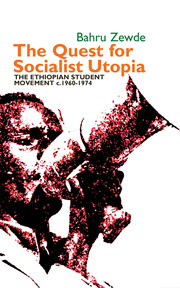Book contents
- Frontmatter
- Dedication
- Contents
- List of Illustrations
- Acronyms
- Abbreviations
- Glossary
- Note on Transliteration
- Note on the Ethiopian Calendar
- Acknowledgements
- Introduction
- 1 Youth in Revolt
- 2 The Political and Cultural Context
- 3 In the Beginning: ‘That Will Be the Day, When …’
- 4 The Process of Radicalization
- 5 1969: Prelude to Revolution
- 6 Championing the Cause of the Marginalized: The National Question and the Woman Question
- 7 Fusion and Fission: From Student Unions to Leftist Political Organizations
- 8 Conclusion: The Legacy
- Bibliography
- Index
3 - In the Beginning: ‘That Will Be the Day, When …’
Published online by Cambridge University Press: 05 April 2014
- Frontmatter
- Dedication
- Contents
- List of Illustrations
- Acronyms
- Abbreviations
- Glossary
- Note on Transliteration
- Note on the Ethiopian Calendar
- Acknowledgements
- Introduction
- 1 Youth in Revolt
- 2 The Political and Cultural Context
- 3 In the Beginning: ‘That Will Be the Day, When …’
- 4 The Process of Radicalization
- 5 1969: Prelude to Revolution
- 6 Championing the Cause of the Marginalized: The National Question and the Woman Question
- 7 Fusion and Fission: From Student Unions to Leftist Political Organizations
- 8 Conclusion: The Legacy
- Bibliography
- Index
Summary
Students can write on any topic under the sun, except on politics and religion
THE INSTITUTIONAL SETTING
Secondary education is a post-1941 phenomenon in Ethiopia. It started with the founding in 1943 of the first secondary school, Haile Sellasie I Secondary School; in popular parlance, it became more famously known as Kotebe, after the locality in the eastern outskirts of Addis Ababa where it was situated. It was followed three years later by another school in the diametrically opposite western outskirts of the capital: General Wingate Secondary School, named after the charismatic British commander who led the British campaign of liberation in 1940–41 and went on to be a legend in the British Burma campaign. In other cases, elementary schools expanded to include secondary education. Such was the case with Tafari Makonnen School, already established in 1925. It was the Jesuit administrators of TMS (as it was more popularly known) who were deployed to establish the first institution of higher education in Ethiopia, the University College of Addis Ababa (UCAA). The person who was in the forefront of this undertaking was Dr Lucien Matte, director of TMS, who was asked by Emperor Haile Sellassie in January 1950 to start the college. The institution was initially intended to bear the name Trinity College – probably in an attempt to emulate the Cambridge institution of that name.
- Type
- Chapter
- Information
- The Quest for Socialist UtopiaThe Ethiopian Student Movement, c. 1960-1974, pp. 73 - 100Publisher: Boydell & BrewerPrint publication year: 2014



